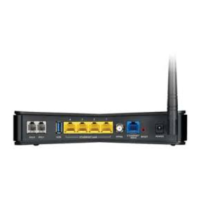Chapter 8 Home Networking
VMG4381-B10A User’s Guide
140
8.4 The UPnP Screen
Universal Plug and Play (UPnP) is a distributed, open networking standard that uses TCP/IP for
simple peer-to-peer network connectivity between devices. A UPnP device can dynamically join a
network, obtain an IP address, convey its capabilities and learn about other devices on the network.
In turn, a device can leave a network smoothly and automatically when it is no longer in use.
See page 134 for more information on UPnP.
Use the following screen to configure the UPnP settings on your Device. Click Network Setting >
Home Networking > UPnP to display the screen shown next.
Figure 55 Network Setting > Home Networking > UPnP
The following table describes the labels in this screen.
IP Address If you select Manual Input, enter the IP address that you want to assign to the
computer on your LAN with the MAC address that you will also specify.
Apply Click Apply to save your changes.
Cancel Click Cancel to exit this screen without saving.
Table 33 Static DHCP: Add/Edit (continued)
LABEL DESCRIPTION
Table 34 Network Setting > Home Networking > UPnP
LABEL DESCRIPTION
UPnP Select Enable to activate UPnP. Be aware that anyone could use a UPnP application to open
the web configurator's login screen without entering the Device's IP address (although you
must still enter the password to access the web configurator).
UPnP NAT-T Select Enable to allow UPnP-enabled applications to automatically configure the Device so
that they can communicate through the Device by using NAT traversal. UPnP applications
automatically reserve a NAT forwarding port in order to communicate with another UPnP
enabled device; this eliminates the need to manually configure port forwarding for the UPnP
enabled application.
Apply Click Apply to save your changes.
Cancel
Click Cancel to exit this screen without saving.

